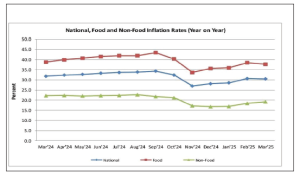Malawi’s inflation rate slightly eased to 30.5 percent in March, a drop from 30.7 percent recorded in February, according to the latest data from the National Statistical Office (NSO).
The fall in inflation, in the month under review, was driven by declines in both food and non-food prices, the data shows.

Food inflation, according to the NSO data fell to 37.7 percent in March, compared to 38.5 percent in February, primarily due to rising maize prices.
Maize, a staple food for most Malawians, has faced significant supply shortages following a poor 2024 harvest. This has forced the country to depend on imports, which are becoming increasingly expensive due to a depreciating Kwacha and ongoing foreign currency shortages.
Meanwhile, the onset of the maize harvest season in Malawi has brought promising economic relief, as inflation rates show signs of decline. With an increase in maize supply, one of the country’s staple commodities, food prices are stabilizing, leading to a reduction in overall inflationary pressure.
On the other hand, non-food inflation also fell to 18.5 percent, up from 19.2 percent the previous month, the data shows.
In the 2025/26 National Budget, the government projected an annual average inflation rate of 24percent for the year, citing measures to stabilize commodity prices and improve agricultural output as key strategies.
Economic experts, however, have urged the government to act swiftly to address the underlying causes of inflation.
They emphasize the need for policies that enhance food security, stabilize the currency, and reduce reliance on imports. As Malawi navigates these economic challenges, the focus remains on finding sustainable solutions to protect vulnerable households and foster economic resilience.




